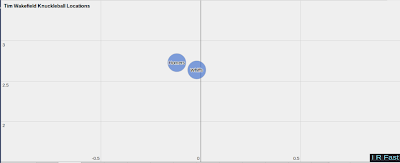R.A. Dickey has not been able to repeat his Cy Young season after being traded to the Blue Jays. Even adjusting for league change (that is, facing tougher competition on average), Dickey has regressed to a level that is closer to how he pitched with the Twins than the one he pitched at with the Mets.
I hadn't touched Dickey yet because I knew I would have nothing to add to the great research already done on knuckleballs. However, I had found no good articles talking about and trying to quantify Dickey's pitch locations from this season. The best articles I have read on Dickey's 2013 have been about movement (and release point) and velocity. There was some thought that maybe he was back, but his horrible start against the Twins on Saturday suggests otherwise.
Even Dickey himself said his dominant start against the Rays was more about location (though nearly all pitchers say that). So,. using average locations, I thought it would be helpful to take a look at how he is locating the knuckleball, and whether that gives us a better look and understanding as to why Dickey is struggling. When it comes to location, I am only going to look at the knuckleball in this post, as that is his feature pitch and what everyone talks about when discussing Dickey. First, let's compare his average knuckleball location in 2012 and 2013 (entire graph is the strike zone):
Dickey is throwing the knuckler slightly more arm side and lower on average than he was in 2012. I originally got the idea for this post because of how high the average knuckler swinging strike was on average. I thought that the knuckler being higher would be a bad thing, but his dominant 2012 had an average knuckler very high in the zone. Just to make sure that the higher knuckler is a better knuckler, the following graphs break down his average knuckleball locations sorted by result. First, here is 2013
Dickey's whiffs this year come when he gets the knuckler glove side on average and keeps the ball high. When he gives up contact (no real difference in average location between contact and homers for him this season), it is on pitches lower in the zone and more arm side. We get similar results when looking at 2012
So it would appear that a high knuckler is a good thing. I was curious to see if this was unique to Dickey, so I looked at the other pitcher with a high volume of knucklers in the Pitch F/X era
While getting it glove side was better for Wakefield (just like Dickey), he succeeded more when he got the knuckler low. So perhaps this is more unique to Dickey's "hard" knuckleball. However, Dickey is still having success up despite the velocity drop. The problem is that he just isn't getting it up quite as much.
Despite the location changes, his actual release point change has been very minor
One would expect (at least I would expect), that if he was hurting, he would have a harder time getting the ball down. Instead, the problem is that he is not getting the ball up. It is not as if a softer knuckler can't stay up, as Wakefield's appears to have stayed up on average, throwing it in the top half of the strike zone. Perhaps there is a slight mechanical issue I am missing, as it does not appear to be Rogers Centre, as he is locating the knuckleball higher at home (2.6 feet on average versus 2.45 feet on the road).





No comments:
Post a Comment